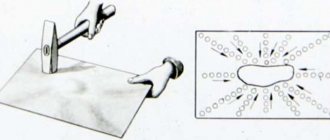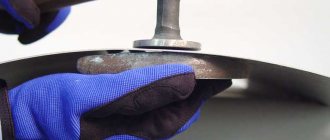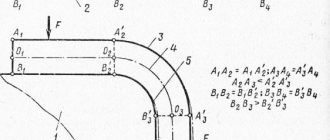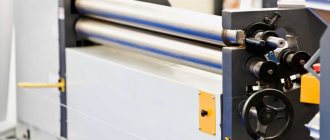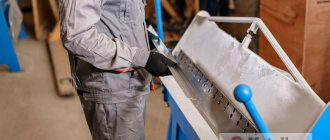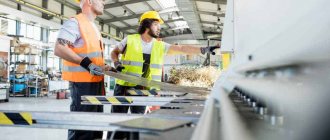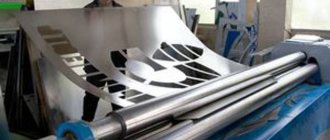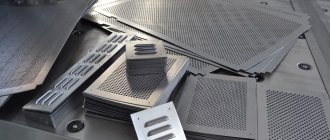During operation or processing, parts made of metal often lose their original configuration. The same phenomenon can be observed if they are not stored carefully. But in order for the parameters of the finished product to meet the requirements of the technical specifications, for the correct implementation of all further stages of processing, it is very important that the dimensions of the workpiece and its shape match the values specified by the project. To do this, an intermediate preparatory technological operation is performed, called “metal straightening”.
Types of editing
A cylindrical workpiece may bend under the influence of an external load, and one with a sheet configuration may become wrinkled. Products in the form of axes that do not even transmit torque, as well as shafts, can bend. The technological operation of straightening metal is understood as a series of actions, upon completion of which the workpiece made of metal returns to its original shape. Defects/flaws come in a variety of forms. The most common ones are:
- convex. It appears on flat products in the form of an increase in thickness - the size of the cross-section of the sheet - from the edges towards the center;
- dent. A recess on the surface of a metal plate, framed by flat edges;
- wave. This is a deviation of the shape of the sheet surface from straightness.
There are two types of editing:
- manual. It is carried out when home craftsmen produce uniquely shaped products. Although the set of tools used is quite simple, high demands are placed on the worker’s skill level;
- mechanical. Used in industrial production conditions. The equipment is very complex, large-sized and heavy. But it is characterized by a high level of productivity, and its design makes it possible to automate the straightening process.
It is not allowed to perform such an operation at subzero temperatures. In this case, the level of ductility of the material decreases and it becomes brittle. Moreover! Sometimes it is necessary to heat the workpiece to a temperature of 140°C to 400°C. After this, its plasticity increases
Sheet and other types of blanks
Billets produced by rolling have increased plastic properties , since they experience large degrees of deformation during production. This allows you to apply methods to them that give a positive result when performing the technological operation of editing. Rolled products of any shape : rod, coiled wire, round and profile pipes, sheets, strips, tapes, angles, beams, channels and others can be used as blanks for proper operations.
This is interesting: Tools for straightening metal
Editing metal sheets
The complexity of this operation depends on the type of defect detected. But special difficulties arise when their combination is revealed. For example, a convexity in the center of the plate and at the same time a wavy edge.
Convex
When straightening a convexity, blows should be applied around the circumference. You need to start with the line framing the defect. As work progresses, the radius of the circle must be gradually reduced, moving from the edge of the convexity to its center. As you progress, the frequency of strikes increases, and their strength, on the contrary, becomes less.
A special approach is used when there are several such defects on the sheet. In this case, by striking with a hammer, you need to ensure that the convexities are combined into one common one, after which the editing is carried out according to the method described above.
Waviness
Editing a metal sheet with wavy edges is carried out starting from its edges and then moving towards the center. The waviness of the edges is smoothed out after the plate is stretched in the middle.
Thin sheets
Processing of workpieces with a small thickness in order to return them to a flat configuration using strikers is not carried out. The reason is that metal creases may occur as a result of unforging. A thin sheet is straightened with long, even planes of smoothing bars made of wood or steel. Smoothing is done in different directions with gradually increasing pressure.
Preparing the production of metal structures
Rice. 15. Scheme of straightening sheet steel on sheet-straightening rollers: 1 - sheet steel; 2, 4 - upper rollers; 3 - lower rollers.
Fig. 16. Mechanized roller conveyors for sheet-straightening rollers: 1 - feed roller conveyors; 2 - rollers; 3 — receiving roller conveyors.
Straightening sheet steel on rollers involves placing the deformed sheet in the gap between the upper and lower cylindrical rolls, arranged in a checkerboard pattern (Fig. 15). The gap between the upper 2, 4 and lower rolls 3 is set slightly less than the thickness of the straightened sheet 1. When moving, the sheet bends many times and elastoplastic or plastic deformations appear in it, which stretch the sheet and eliminate its irregularities. The lower work rolls 3 are driven by an electric motor through a gearbox. The upper rolls 2, 4 rotate due to friction with sheet steel 1 and are moved in the vertical direction by an electric motor through a transmission mechanism. The two upper outer rolls 4 move vertically independently of each other and the middle work rolls. The lifting height of the upper rolls is controlled by the lifting height indicator; The gap between the upper and lower rolls is determined, the size of which is determined by the thickness of the straightened sheet and the yield strength of the steel.
When straightening on sheet-straightening rollers, it is necessary to use driven feed and receiving roller tables to feed the sheet into the rollers and receive the straightened sheet (Fig. 16). Loading and removing sheet steel from roller tables is carried out by overhead cranes. After turning on the mechanism of the lower rollers of the sheet-straightening rollers, the mechanism for rotating the rollers of the feed rollers 1 is turned on. The rollers of the roller conveyor feed sheet steel into the rollers 2, and then it moves in the rollers due to the rotation of the lower rollers. Sheet steel passes through the rollers onto the receiving roller conveyor 3 and, depending on the need, is either passed through the rollers in reverse for repeated straightening, or removed from the roller conveyors by an overhead crane for stacking. On sheet-straightening rollers, the crescent shape of universal steel can be eliminated by placing steel spacers 2-4 mm thick on the concave zone. The rollers, compressing the universal steel in the place of the spacers until plastic deformation, lengthen it in the compressed zone and straighten the crescent shape.
Sheet steel up to 5-6 mm thick can be straightened in batches of 3-4 sheets at a time. The number of sheets in a package depends on the mechanical properties of the steel, the curvature of the sheets, the qualifications of the straightener, the thickness of the sheet and the parameters of the rollers.
To eliminate local convexities (flaps), most often found in thin sheet steel, spacers must be placed on both edges of the sheet surface and passed through rollers. The fibers of the sheet under the spacers are elongated, resulting in the elimination of the bulge.
Straightening of angle steel is carried out on angle straightening rollers or straightening presses. Angle straightening rollers simultaneously eliminate curvature in two planes, as well as grinding or grinding of corners. On straightening presses, curvature in two planes is eliminated in two steps. The accuracy of straightening angle steel (curvature) is determined by the curvature arrow, the maximum value of which is allowed up to 1/1000 of the length, but not more than 10 mm. Grinding and grinding is determined by the gap between the outer planes of the corner shelves and the square, the size of which is allowed no more than 1 mm per 100 mm of the shelf width. Straightening of angle steel, similar to sheet-straightening rollers, is carried out by two rows of rollers arranged in a checkerboard pattern. The upper idler rollers rotate freely on axes fixed in two frames and are moved vertically by a steering wheel. The lower working rollers rotate from an electric motor through gearboxes and can move along the axis. This makes it possible to ensure high quality straightening due to precise adjustment of the position of the rollers. The upper and lower shaped rollers are replaceable and are mounted on the ends of the rolls protruding from the frame.
The profile of the rolls ensures that the corner is positioned with the back side down and the flanges at an angle of 45° to the vertical.
Straightening of hardened metal products
In this case, hammers equipped with soft strikers are not used for straightening. For this purpose, a tool with similar elements made of steel with high strength characteristics is used. In this case, the sharp part of the striker - the nose - is rounded, that is, it is given a rounded configuration.
Straightening of hardened metal is carried out by applying pulsed point effects on a concave fragment of the workpiece. As a result of impacts in this area of the workpiece, a stretching of the material structure is observed, due to which the surface becomes more and more flat. This operation is carried out:
- on a straightening/straightening headstock, characterized by a hemispherical surface;
- with alternating movement of the workpiece from bottom to top and top to bottom. Straightening a hardened square whose right angle is broken is carried out in one of the following two ways (see figure):
- if the angle has become acute, the direction of the blows is the internal section of the surface of this part closest to the point of intersection of the rays/sides;
- when the angle has transformed into an obtuse one, the place of striking is the zone close to the top of the outer angle.
The metal in the affected area is subject to tension, as a result of which the 90° angle is restored.
Straightening rounded metal parts
The method for performing editing in this case is practically the same as when processing a strip. Irregularities must be marked with chalk, and the workpiece must be placed so that the bulge is on top. Impacts should be applied in the direction from the peripheral areas of the defect to the central ones.
After correcting the main flaw:
- the part turns around its axis;
- the force of the blows decreases.
This is done in order to prevent deformation of the workpiece in the opposite direction.
A similar approach is also relevant when working with rectangular or square rolled metal.
Equipment for straightening/straightening
Manual straightening/straightening of metal sheets and structural elements made from them is carried out using hammers on special equipment - straightening headstocks, as well as straightening plates.
Straightening headstocks
For the manufacture of these devices, heat-treated steel alloys are used. The working surface of the straightening head can be:
- in the form of a flat circle on a cylindrical base, the radius of which (designation R) ranges from 150 mm≤R≤200 mm:
- spherical. This is the lateral surface of a cylinder truncated along the plane of symmetry and along the edges.
Also, in home workshops, a railway rail, cut to a length of 0.5 m to 1 m, is often used as a straightening headstock. It is convenient to move it along the slab. In addition, the rail is not subject to deformation and remains practically motionless when the workpiece is struck with a hammer.
Correct slabs
Straightening slabs are available in two modifications.
- Manufacturing material – cast iron. Execution – design with side ribs or solid.
- Manufacturing material – steel.
The slab must be heavy and sufficiently stable so that hammer blows do not cause it to shake. As for the requirements for the condition of its surface, they are standard: it must be perfectly smooth, and without the presence of foreign particles in the form of dirt and remnants of metal fragments that interfere with obtaining a high-quality result of straightening work.
The slabs must be installed on supports. They can be either metal or wood. But the most important thing is that these stands provide, in addition to stability, the required horizontal position. To make straightening easier, you need to have enough space around the slab.
There is another interesting option for such equipment. The material used to make the correct slab is dense rubber with many small protrusions, or rather, even tubercles with the same height. Under the influence of impacts, the metal itself determines its place. As a result, there is a significant increase in the productivity of the straightening process when compared with the use of a conventional leveling plate made of steel.
Hammers
The following key requirement is imposed on hammers used for straightening: they must be softer than the material of the workpiece being processed. In view of this, for straightening sheet steel, an impact tool with lead or copper strikers is usually used. Moreover, these elements should be characterized by a rounded shape. A square-shaped firing pin will leave nicks on the metal plate upon impact. When it comes to processing soft metals or non-ferrous alloys, it is necessary to use hammers equipped with rubber or wood strikers.
Convenience of work will be ensured if the ratio of the weight of the impact tool and the same parameter of the correct plate is equal to 1:100.
Sheet metal straightening machines
In metal rolling production, as well as in the mechanical engineering sector and in enterprises that manufacture complete parts for various industrial, scientific and medical equipment, sheet straightening rollers are used for straightening sheet metal. These devices have been modernized in accordance with the times to accurately and quickly process sheet-type metal workpieces.
Device of sheet-straightening rollers
Sheet straightening rollers consist of two interconnected mechanisms - the working area and the device drive. The general design of equipment for straightening sheet metal consists of motors, frames and cylindrical rolls, which are placed in a staggered, two-tiered pattern in bearings. The bearings are fixed in the equipment frame.
One of the electric motors of the equipment, equipped with a gearbox, sets the rotational movement of the lower roller part of the drive during the working process.
Another electric motor, using a gear mechanism, raises and lowers the upper roller part of the drive device.
By design, sheet-leveling rollers are equipped with two special work tables, which are called roller tables.
The front roller conveyor serves to feed metal sheets into the rollers, and the rear one ensures support of the product after processing at the exit. Passing a sheet of metal between the rollers, it is straightened by repeated bending. If the condition of the workpiece has large-scale deformation, then the product is passed through the rollers repeatedly.
Operating principle of sheet straightening rollers
When the machine is started, the shafts of the gear cage transmit the guiding movement to the rollers, which carry out the process of straightening the product. The transmitting movement is carried out using articulated spindles.
The articulated spindles in the sheet-straightening roller device are capable, thanks to their unique connection, of turning in all planes. Unlike the upper rollers, which are installed in a mobile traverse, the lower row of rollers has a fixed axis fixed in the racks of the device frame.
The position of the movable traverse is adjusted through the control panel with an indicator device.
A properly organized process of straightening metal sheets using equipment such as sheet-straightening rollers has a significant impact on the efficiency and quality of work carried out with metal.
Therefore, to improve and optimize the work process, the equipment is equipped with a centering device that operates on the principle of pneumatic systems.
Lifting and removal operations during the operation of straightening rollers are carried out using special sheet stackers with magnetic properties.
Sheet straightening rollers are not cheap equipment.
Therefore, to purchase devices, it is necessary to choose only a supplier that has been verified by many positive recommendations and who can ensure delivery of equipment that meets all requirements in the shortest possible time.
In addition to delivering the equipment to the area of further stationary operation, it is worth discussing in advance the conditions for installation of the machines and further maintenance for the period specified in the warranty card.
There are certain types of sheet-straightening rollers for different enterprises. They differ in performance levels, sizes and sets of additional equipment. Accordingly, for a private blacksmith shop, you can choose a machine whose cost will be significantly less than the cost of the equipment necessary for large-scale production.
| Processing metal products by galvanic method is one of the most common and popular coating methods. With his help… |
| Today, baling presses for scrap metal processing have fairly high performance and are capable of processing large amounts of scrap, even… |
| Machines for bending reinforcement are an indispensable thing for construction organizations and industrial enterprises. Steel reinforcement is used as the main reinforcing material, and therefore it is very popular in the construction of various engineering structures and buildings... |
| The initial element from which the entire process on equipment for the production of metal profiles actually begins is the unwinding device. It is on this that it is strengthened... |
| The operating principle of a correct cutting machine is as follows. Initially, the machine starts, the operation of the machine is carried out by an electric motor. Through clinometer type transmission... |
| The working process of producing a spring on a spring-coiling machine involves the presence of such basic stages as the initial preparation of material for the manufacture of a spring-type product. Then after the material... |
